The ASUS ZenBook 3 Review: A Convincing Case for Quad Core Thin & Light Laptops
by Brett Howse on November 22, 2017 8:00 AM EST- Posted in
- Laptops
- Asus
- Zenbook
- Core 8th Gen
- Kaby Lake Refresh
Display Analysis
ASUS has gone fairly conservative with the display options for the ZenBook 3, as the only display choice as a 1920x1080 14-inch panel. It’s not low resolution by any means, with a 157 pixel-per-inch density, but compared to the UHD offerings, it seems like it is. Still, in a 14-inch laptop, it’s a reasonable resolution, and will hopefully pay dividends when we get to battery life. It’s still great to see a 14-inch panel in a laptop of this size, and the slim bezels help out here.
ASUS has targeted 100% of the sRGB gamut, and we’ll see how they did shortly. By not going with a wider gamut display, they don’t need to deal with the shortcomings of Windows in terms of color management.
The display features a Corning Gorilla Glass 5 cover, which should help prevent damage, but there’s no touch available. There’s also no support for a pen. It would be nice to see a touch option, even if not everyone would use it, but for traditional laptop functions, you can get by with the Precision touchpad.
To test display accuracy and performance, we use SpectraCal’s CalMAN suite, along with an X-Rite i1DisplayPro colorimeter for brightness and contrast measurements, and an X-Rite i1Pro2 spectrophotometer for color accuracy.
Brightness and Contrast

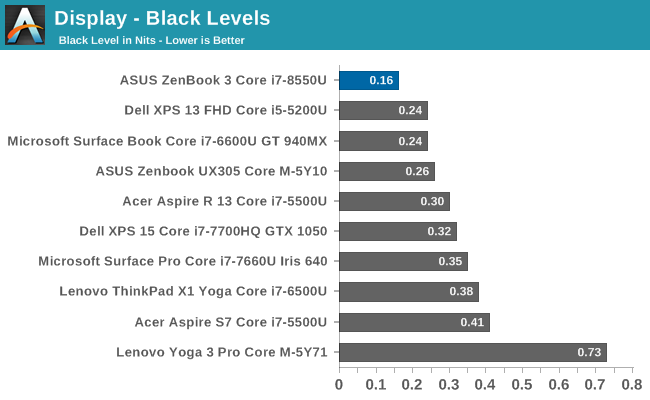
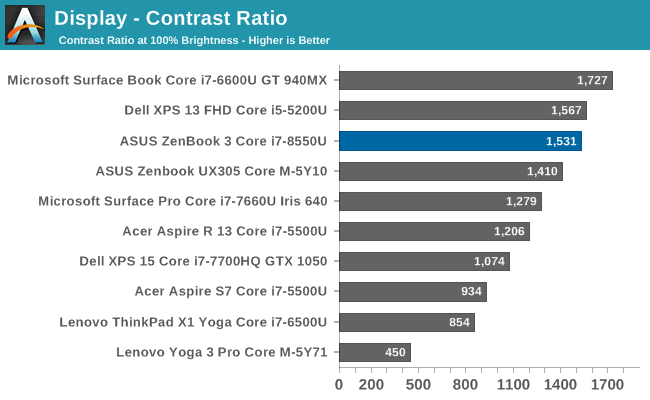
The ZenBook 3 doesn’t offer a very bright display, and would struggle to be used outdoors or in bright sunlight. It does offer great contrast though, coming in near the top of the list in that department. On the bright side, it can get fairly dim, with a minimum brightness of just 13 nits.
Grayscale
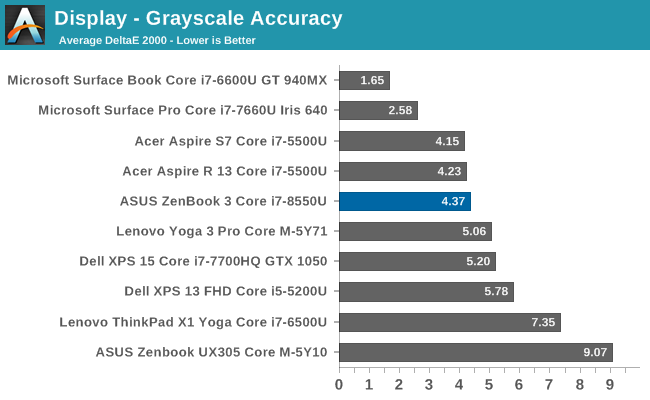
Testing the grayscale demonstrates some immediate issues with the display. The gamma is far from the ideal 2.2, and the blue levels creep up with brighter whites, while the reds drop off, resulting in a very cool display. The overall average dE isn’t terrible, but ASUS has never calibrated their laptop displays, and clearly they haven't started with the ZenBook 3.
Gamut
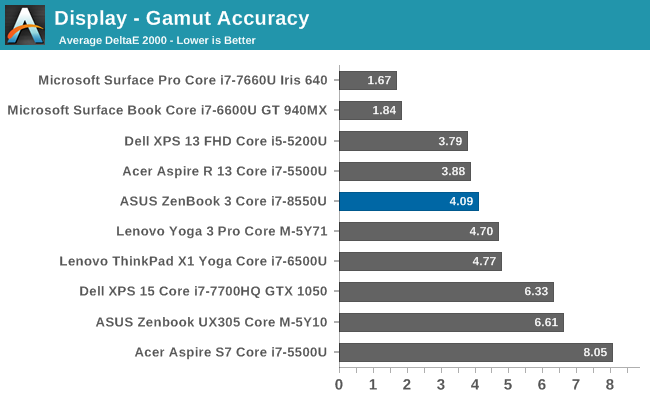
Coming from the grayscale results, it’s not a surprise to see that the blue levels are oversaturated on this display, with the 100% blue values well outside the sRGB range.
Saturation
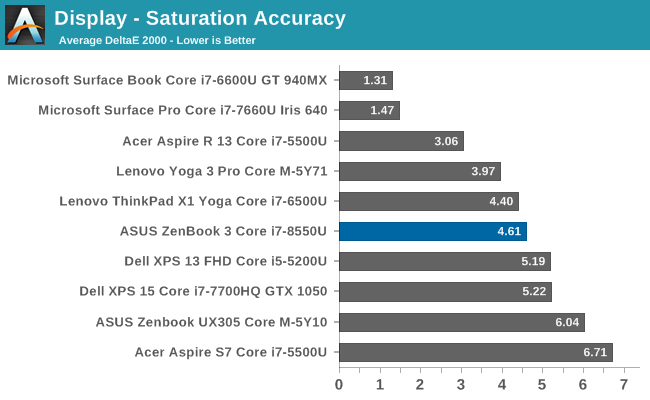
Our saturation sweeps show that all of the primaries are not quite where they should be, which drag the secondary colors out as well. The overall error level isn’t massive, but on a high cost device, there’s not a great reason to see the lack of any work done on color accuracy.
Gretag Macbeth
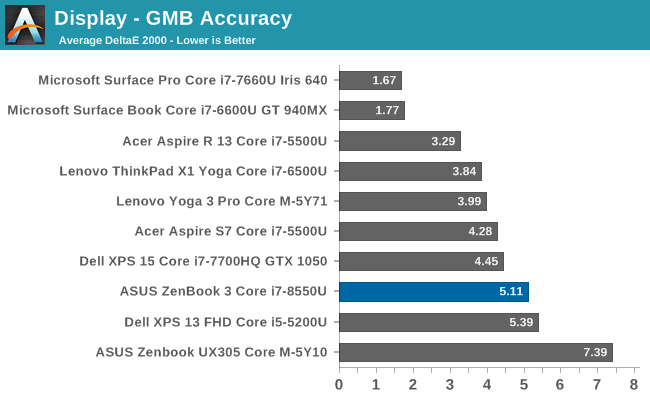
The Gretag Macbeth test covers a wide range of colors, and can show errors with colors such as flesh tones, even if the primary and secondary colors are not too bad, and that’s the case here. The overall error level average isn’t terrible, but on a premium device you should expect better.
This image shows the relative color error levels that you’d see on this device, with the displayed color on the top, and the correct color on the bottom. Your own display may impact these results though if it isn’t accurate, which is why this is only a relative difference.
Display Conclusion
ASUS has never been a company that has done any sort of color calibration on their displays, and that is clearly the case here again. On a low-cost device, you can overlook this, but some of the competition at this level does do individual calibration on their devices. If you’re after a notebook just for office tasks, these color errors will only be an annoyance, but if you’re after something to edit video or photography, you should likely look elsewhere.


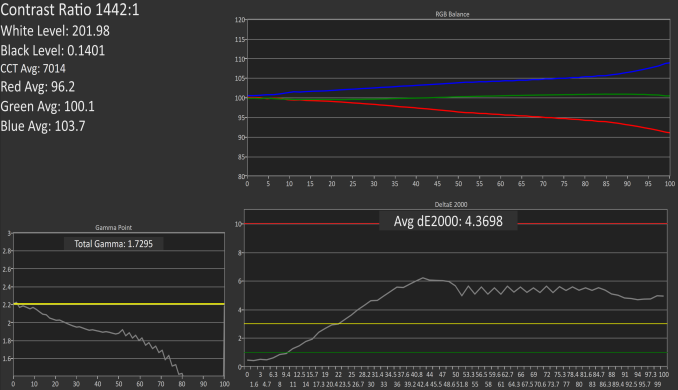

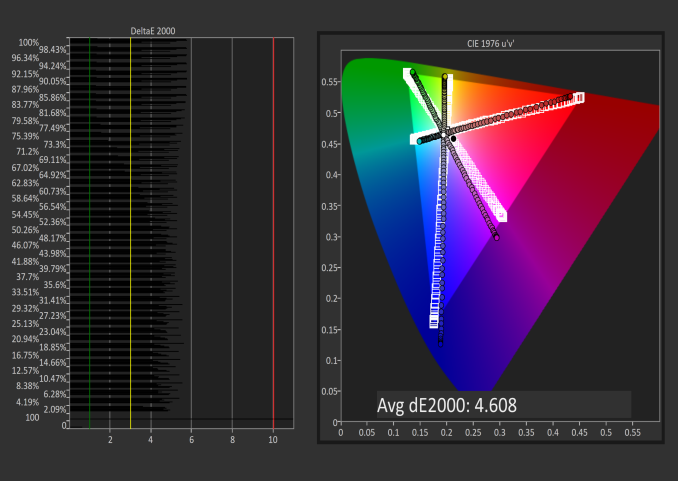










55 Comments
View All Comments
aeronatis - Wednesday, November 22, 2017 - link
I believe they prefer to implement LPDDR to be able to reach long battery runtime during sleep. With standart DDR, any sleeping computer is pretty much out of juice overnight whereas laptops with LPDDR can sleep for days.DanNeely - Wednesday, November 22, 2017 - link
I've been able to sleep Dell Latitudes used by my previous employer over the weekend since the 2008(?) models; AFAIK all of them used standard DDR2/3 not low power sorts.hybrid2d4x4 - Thursday, November 23, 2017 - link
Overnight? That's a pretty major exaggeration. I had a Acer 3830TG (Sandy bridge, 4GB DDR3) that lasted >3 weeks in sleep. And before anyone says it, I always "powercfg -h off" on a new system/OS install.wolrah - Wednesday, November 22, 2017 - link
@labrats5 Who said anything about LPDDR3?@Jimios basically I'm looking for a powerful, portable machine on which to run VMs and do development. It'll never run games or even Windows so an nVidia or AMD GPU is just wasted silicon, wasted power, and annoying driver problems. I'd rather just use the Intel GPU that's built in to the processor and has great Linux support, but basically every proper workstation laptop forces a Quadro on you.
If I want to avoid the GPU I'm stuck looking at the thinner models. I don't really care about thin, I think my 2008-era Macbook Pro (the one right before unibody, that was basically an evolution of the Powerbook G4 design) was perfect as far as size/weight goes.
Jimios - Wednesday, November 22, 2017 - link
Can't the dGPU be completely disabled through BIOS/EFI or something? I haven't owned a non-Apple laptop recently so I honestly don't know.As for your use case (multiple VMs, etc.), I understand, but I don't think there would be too much demand for what you're asking. A laptop with your description wouldn't sell well to justify the development and marketing cost, IMO. Laptops like the article we're commenting on are mass market devices.
Also, typically with "workstation laptops" companies aim at CAD/CAM engineers and creative professionals. Which is sad, and I understand your frustration.
DanNeely - Wednesday, November 22, 2017 - link
As a developer currently using a Yoga with 16GB of ram, while I'd rather have a big laptop with a 45W CPU and 32GB of ram; if I could only have 1 I'd go for the ram multiple VMs or copies o Visual studio and a bunch of loaded browsers max out 16GB more often than I'm CPU limited.wolrah - Wednesday, November 22, 2017 - link
"Can't the dGPU be completely disabled through BIOS/EFI or something? I haven't owned a non-Apple laptop recently so I honestly don't know."I have yet to encounter a dual-GPU laptop where all the video ports were wired through the onboard GPU. Usually at least one of the external ports and sometimes the internal display is wired through the dedicated component, requiring that part to be enabled for those ports to work.
On my current Asus with a GT650M the HDMI port is wired through the nVidia chip so if I want to use an external monitor I have to either use VGA (yuck) or deal with the disaster that is nVidia Optimus. Even under Windows it's annoying, under Linux it's a mess.
linuxgeex - Thursday, November 23, 2017 - link
I've felt the same as you for the last decade, but you'd be surprised these days. AMD GPUs are quite well supported out of the box on open drivers, within 6mo of launch, and generally you can get them up on launch day using recent kernel/Mesa releases. I'll be getting an AMD 2500u based laptop this time around. Probably the Acer Swift.timecop1818 - Thursday, November 23, 2017 - link
> basically I'm looking for a powerful, portable machine on which to run VMs and do development. It'll never run games or even Windows so an nVidia or AMD GPU is just wasted silicon, wasted power, and annoying driver problems. I'd rather just use the Intel GPU that's built in to the processor and has great Linux support, but basically every proper workstation laptop forces a Quadro on you.you had me until "never runs Windows", lol.
nice troll, bro, nice troll.
also, accelerated graphics support in lunix. ha ha ha ha ha.
thanks for the laugh.
IGTrading - Wednesday, November 22, 2017 - link
It will be lovely to watch AMD Ryzen Mobile mop the floor with this 1700 USD waste of money.For this much money, I would expect way better performance, but luckily HP Envy x360z with Ryzen Mobile is just 600 USD.
There's nothing in ASUS' new Zen that's worth the extra 1000 USD they're asking.